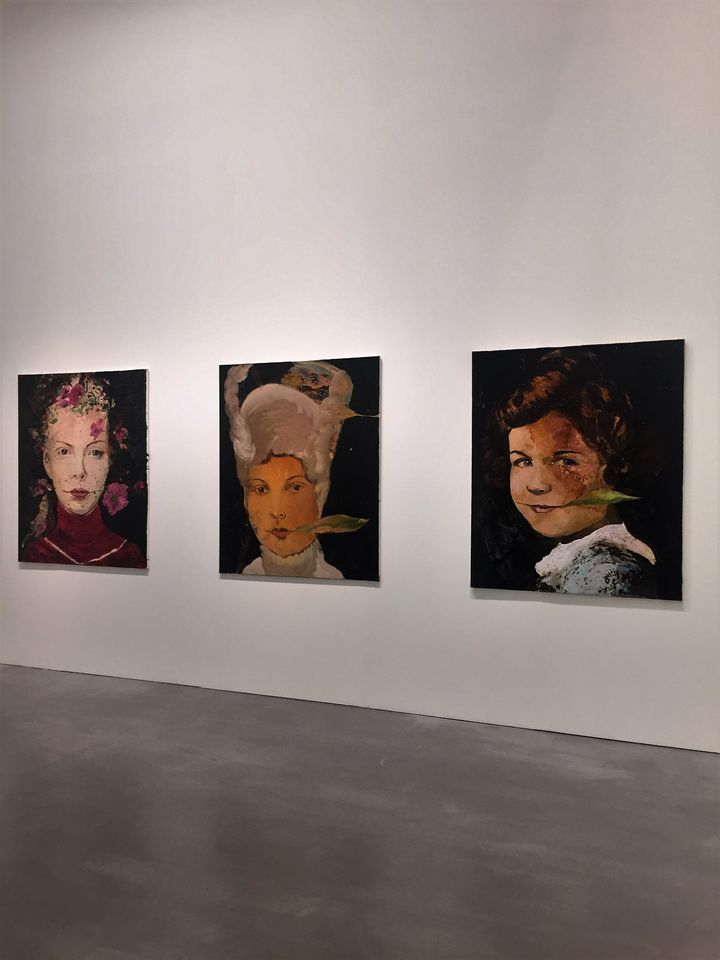
Berlinische Galerie, December, 2016
There’s a painting of a blond-haired girl looking out a window where birds look like they are flying in. The girl doesn’t notice the birds, she’s looking out beyond them to something else. When I saw this painting, A Blink of an Eye, by Cornelia Schleime, it moved me to tears. Maybe it was the eyes of the girl or maybe it was reading how Schleime’s video art got her banned from exhibiting her work in the 80s. One day, she took a few pictures, a duvet, grabbed her son, and snuck over to the West, entrusting that the rest of her work might be sent to her. Someone broke into her apartment and took everything—she had to start again. I cannot stop thinking about her work, at once beautiful and a reminder of what once was, but can never be again.
Contemporary art sometimes leaves me scratching my head because the analytical part of me wants to “get it” so I too can be an eccentric art lover. Alas, the subjective nature of art means I just won’t like things and I’ll love other things for no reason at all but for a visceral reaction, which I had on a cold December day at the Berlinischer Galerie Museum. As I read the placards of her life story next to the work and saw the veracity with which she expressed herself, I was more than curious, I was inspired. I’d never heard of her before, and this made me feel ignorant because she is one of the most important contemporary artists in Berlin. As I went through her work for hours, going through once and then again after a curry lunch at the museum cafe, my impulse was to want to write her in my rusty German to let her know how much her work and story inspired me.
It's my own self-consciousness of my art appreciation that finds me wanting to research and write an academic article about the work as if I need a ‘why.’ Then I thought of the boldness of Schleime’s videos and bondage photos, her time in a punk bank and the culmination of circumstances that got her noticed and banned from exhibiting. Perhaps it was the acute pain of the knowledge that she’d been spied upon for years by her dear friend Sacha Anderson, whom she’d trusted like a brother. In her interview with Oliver Koerner von Gustorf, she says, “To my mind, art means creating a counter-world, against things you don’t like. . . If I didn’t suffer, if I was a happy person who skips through life, I wouldn’t have any themes for my pictures.”[1] I knew then, that I didn’t need a ‘why’ any more than she did—passion and artistic expression don’t require it. Curiosity made me explore embarrassment, shock, and rapture with the work. Decidedly, there was no need for me ‘get it’, but to think bigger about the bold aggression of the work—once censored, forcing an escape and recreation.
Watercolors reflected her childhood struggle with Catholicism. A recovering Catholic, I appreciated the thread for which an indoctrination in childhood, even when removed, can still have impact years later. I felt a keen understanding in this work, as if there was something we shared. Growing up in a clandestine Catholic household, Schleime lived this conflict because in public she was protestant due to the moral reach of the GDR government. The contradiction lead her to leave the religion at seventeen, deciding to become an artist. I left the religion because I could not be confined by rules I did not believe in and felt restricted by.
Rarely does one get an entirely massive gallery to one’s self in Berlin. I stood in the middle of the room with the giant canvases of up-close full head portraits and slowly turned myself in circles so I could breathe it all in. This is a woman of vast talent, fearlessness and edge. In this room, the medium was acrylic paint, the use of light and the poignancy in the eyes of her subjects, mostly women, except for Pope John Paul. This room felt personal to me, liberating even, both that I had it selfishly all to myself and the thought that whatever work I do, I must continue to experiment. Rules don’t apply for Schleime, only that she knows them and is able to break and twist them. She says in an interview with Exberliner, “the most important thing in painting: you decide what you’re going to do and how you’re going to do it in the moment. An artwork is a culmination of moments.”[2]
The strength of the work drew me to it along with the secrets that the subjects hold. I sensed an unabashed resilience without excuse, although it took me time to let it all soak in. Schleime exposes the work by saying, “At first glance, you might think the women are beautiful but then when you see them in person you notice imperfections, that they are injured in some way.”[3] When I read this, I realized that I didn’t need an art education to appreciate the work and it made sense to me why I can’t get the blond-girl with her unknown thoughts out of my mind.
Cornelia Schleime is the winner of the Hannah-Höch-Preis from the State of Berlin for her life’s work. The exhibit is worth a trip to Berlin and will be at the Berlinischer Galerie until April 24, 2017.
[1] Oliver Koerner von Gustorf, ArtMag by Deutsche Bank, Images of Longing A Talk with Cornelia Schleime, db-artmag.de
[2] Jennifer Adams, Exberliner.com, Fighting the System: Cornelia Schleime, January 12, 2017 http://www.exberliner.com/culture/art/cornelia-schleime-interview/
[3] Ibid.

Schleime, A Blink of an Eye
